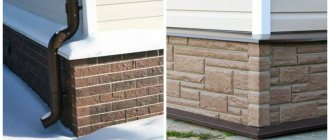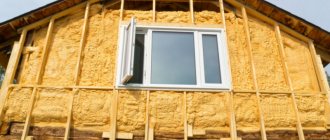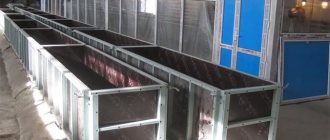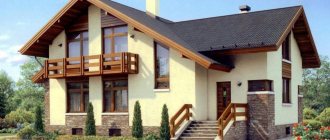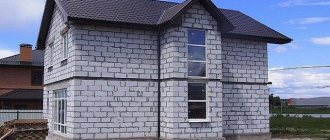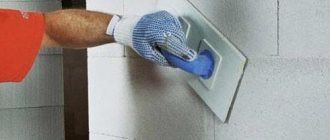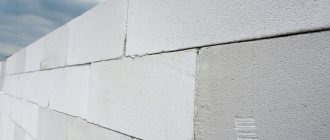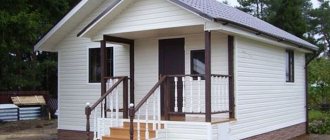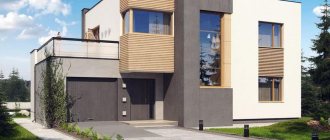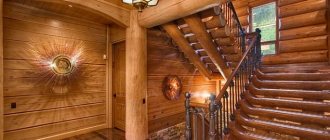Features of finishing foam concrete blocks in rooms
The widespread construction of houses made of foam blocks is due to their advantages over other building materials:
- significant size of the blocks, which makes laying easier and faster;
- low specific gravity, which makes it possible to increase the dimensions of such elements;
- sufficiently high mechanical strength;
- high thermal insulation and noise protection properties;
- resistance to temperatures over a wide range;
- non-flammability;
- harmless to the human body;
- ease of processing with hand tools.
Foam block houses have such an important advantage as the ability of the walls to “breathe”, that is, air can penetrate through the foam concrete.
Why is interior decoration of walls made of foam blocks so necessary? The fact is that most of the positive qualities are caused by the presence of a porous structure. When moisture accumulates in internal inclusions, the material loses its thermal insulation properties. There is a risk of starting the cracking process. At the same time, foam concrete is quite hygroscopic, and moisture easily penetrates into the material. In addition, the occurrence of condensation should be taken into account. Steam easily passes through foam blocks, and when it meets the colder outer surface of the wall, it condenses. The resulting moisture gradually accumulates inside the material, destroying it. Thus, walls made of foam blocks require waterproofing both on the outside of the house and inside the premises.
Houses made of foam blocks: how interior decoration is done
Foam block houses finishing
Houses made of foam blocks are finished both on the inside and on the outside. But today we will touch more on how to decorate foam block walls inside a house. Although recommendations will also be given on the outside. After all, this is a complex job.
In the video in this article you can get additional necessary information and see individual moments of the work from the photo.
Houses made of foam blocks: interior and exterior decoration
The interior decoration of a house made of foam blocks is done only after high-quality application of the external coating. After all, interior decoration alone will be of no use. Moisture will penetrate into the room.
Everything can be done with your own hands, then the price will not be high. This is especially true for plaster.
Foam blocks
The interior decoration of a house made of foam block is done to create a comfortable environment and protect the room from moisture penetration. There are two main types of foam blocks used in construction - foam concrete and aerated concrete. They differ from each other in manufacturing technology, which does not affect their main characteristics.
| Foam block | Foam concrete blocks are made from concrete mortar, to which a special substance is added, which causes the appearance of peculiar cells within the structure of the blocks, 2-3 mm in size. The foam block is kneaded and poured into molds, where it is dried, and then cut according to size. |
| Gas block | Aerated concrete has cells no larger than 1 mm, which makes it more durable and less hygroscopic. It is manufactured using a slightly different technology, which has a larger set of technological operations and the main one is the final drying of products in autoclaves using steam. |
How and with what can you line foam and aerated concrete walls?
There are a lot of finishing options, but some factors should be taken into account:
- Considering the fact that foam and aerated concrete blocks have good vapor permeability, the finishing should also have the same indicators.
- Bottom materials are hydroscopic, and therefore condensation should not be allowed to form inside the blocks, which will inevitably lead to their destruction.
Attention: Based on the above, there are 2 options for finishing such walls, the main thing is to choose the right facing material.
Vapor-permeable finish
This finishing option is very popular. This is not surprising, because it allows the room to breathe, and this is the most important thing.
There are a lot of finishing options. As an option, you can offer a plaster solution, the basis of which is gypsum and which can be purchased at any hardware store.
The composition of such mixtures includes:
Attention: Such plasters can be applied to foam block surfaces without prior treatment with primers. In addition, they are easy to work with, and after them there is no need to apply putty for final leveling of the walls. Moreover, gypsum-based plasters have excellent vapor permeability.
Vapor-tight finish
On the one hand, everything is very simple, but on the other, everything is quite complex and requires very accurate calculations.
Diagram of vapor tightness of a foam block wall
- It is very important here that the structure breathes and, at the same time, does not allow steam to pass through. Vapor-tight membranes are best suited for this, which are capable of not allowing steam to pass in one direction, but allowing air to pass in the other.
- It is not recommended to use polyethylene film or other non-breathable materials for these purposes, or to cover walls with cement-sand mortars, since condensation can accumulate at the border of such materials, which has a negative effect on the foam block structure.
Wall finishing options
The most affordable and easiest way to finish interior walls is to use finishing materials installed on frame structures.
Such materials include: plastic or MDC panels, drywall, etc. The advantage of using such materials is that they can be used to hide all defects in the laying of blocks. In addition, this is dry, not wet work, which can be carried out under certain conditions. The installation of such structures is quite simple and even a non-specialist can handle it.
If you prepare foam block surfaces for painting or wallpapering without using this technology, you will have to work very hard:
- Prepare wall surfaces.
- Carry out puttying work.
- Sand the surfaces after puttying.
- Secure the reinforcing mesh.
These operations will take quite a lot of time; in addition, during the work there will be a lot of dirt, debris and dust.
Wall decoration with plastic panels
In houses made of foam blocks, interior decoration with plastic is most common. The manufacturer produces many varieties of plastic panels, both in design and in shades.
There is a large selection, so you can easily choose to suit your taste. By doing the same interior decoration, you can also do the insulation of the room without any problems.
Installation of sheathing for foam block
- The design of plastic panels involves their installation on a wooden frame. In addition to plastic panels, various accessories are produced, such as starting profile, internal and external corner, plastic skirting board, connecting strip, etc. They help to properly install the plastic lining.
- To make the frame, you will use bars with a cross section of 20x25 mm, well dried and even. They are attached to foam concrete blocks using dowels and self-tapping screws. For reliable fastening, taking into account the internal structure of the blocks, you should take dowels about 100 mm long, and the length of the screws is selected taking into account the thickness of the rail, that is, +2 cm.
- To fasten the sheathing slats, you can use brackets for fastening profiles CD-60, which is used in plasterboard systems.
- They begin to mount the frame by attaching the bottom and top rails. Since the panels will be mounted vertically, the slats are mounted horizontally. Having aligned and secured the outer slats, ropes are pulled between the outer slats to control the evenness of the sheathing.
- But, as a rule, many craftsmen do not do this, because the ropes then not only help, but also seriously interfere with the installation of intermediate slats. It is better to use a flat rod or rule, length from floor to ceiling, for control.
- First, all the holes are drilled, all the slats are pre-installed, then, using a slat or rule, all intermediate slats are finally and securely fixed. Installation of the panels begins with the installation, if necessary, of a plastic plinth at the bottom and top, as well as internal and external corners and, if necessary, starting profiles are installed.
- The surface is sewn either from left to right or from right to left. The first strip is installed in a plastic corner or starting strip with the end part, and the bottom and top are installed in a plastic plinth, after which the panel is nailed to the sheathing with nails (L = 20 mm) or staples, using a stapler for this purpose.
- When installing and fixing each panel, you must remember to control its position with a building level. The last strip is cut not only lengthwise, but also lengthwise, depending on the size. As a rule, it is not nailed down, but simply inserted into the groove of the previous lining and the groove of the corner or starting profile.
Plastic panels have their advantages and disadvantages:
- Their main disadvantage is their weak mechanical strength. Because of this, it is problematic to install them in areas of heavy traffic or if there are small children in the house who can damage the plastic panels.
- The frame structure of the cladding allows you to install additional thermal insulation between the panels and the foam block wall. This is another step towards energy saving.
How to paint walls correctly
Recently, there has been a tendency that this method of wall covering is no longer popular and many people prefer wallpapering. Painting walls has not ceased to be popular when decorating cafes, shops, supermarkets, as well as various administrative buildings. What's the matter?
But the fact is that:
- To obtain a high-quality surface after painting, the surface is prepared very carefully before painting, starting with the puttying process and ending with the sanding process. The peculiarity of the painted surface is that it is capable of showing all the defects of the treated surface: small irregularities, tubercles, and also polishing defects.
- The paint also needs to be prepared in terms of color selection, which is difficult to do in a renovation situation: you have to add different dyes several times to get the desired shade.
Attention: The paint must be applied in at least 2 layers; this is the only way to obtain a high-quality coating. Each subsequent layer is applied perpendicular to the previous one: if the first layer was applied from bottom to top, then the next one is applied from left to right, or vice versa.
External cladding of foam block structures
The external decoration of a house made of foam blocks is extremely important. The peculiarity of foam block structures is that they need to be closed, including from the outside, to protect the walls from atmospheric influences.
Scheme of external finishing of foam blocks
- A ventilated facade may be an ideal option. You can use siding as a facing material. It will minimally load the foam block structure, and the ventilated gap will protect the structure from excess moisture that can form at the wall-cladding interface.
- Plus, in this gap you can add insulation in the form of mineral wool, which meets all the requirements for this kind of cladding.
Other types of finishes
The most common type of interior decoration is wallpapering.
This is due, first of all, to a wide range of different types of wallpaper:
- Paper-based wallpaper.
- Non-woven wallpaper.
- Vinyl wallpaper.
- Washable wallpaper.
Moreover, you can choose wallpaper by color, design and pattern, and structure. The choice is so large and varied that many people have difficulty choosing wallpaper for themselves, spending a lot of time on it.
- Rooms such as the toilet, bath and kitchen are usually finished with ceramic tiles, the range of which is as wide as the range of wallpaper. If the toilet and bathtub are completely tiled, then the kitchen can be tiled with a combination of ceramic tiles (work surface) and wallpaper. Moreover, choosing wallpaper to match the tiles is not difficult.
- For exterior finishing, we can recommend a simple, affordable and widespread method - this is finishing with structural plasters, over a pre-installed layer of insulation made on the basis of polystyrene foam or polystyrene foam.
- The effect of this option is very large, since it is based on an integrated approach: additional insulation is carried out using modern cladding materials that provide the building with an attractive appearance.
You understand how to finish walls made of foam blocks inside a house; this should first of all be protection from moisture. So choose the right material and the instructions will help you with this.
Finishing principles
Do-it-yourself finishing of walls made of foam blocks has its own specifics. First of all, it should be taken into account that the smooth surface of the elements and the composition of foam concrete do not allow the use of conventional cement-sand mortars, which do not have reliable adhesion to the material in question. To ensure good adhesion, special primers designed specifically for these purposes are applied. Such products are able to penetrate 3-4 mm deep into foam concrete, which improves adhesion and reduces hygroscopicity.
The quality of finishing work largely depends on the correctness of the laying of blocks during the construction of walls. If special glue was used during the construction of the walls, then the interblock seams are no more than 2-3 mm wide, which provides a fairly smooth wall surface, which facilitates the application of a protective coating. In addition, when laying, the walls must be reinforced with reinforcing belts every 4-5 rows of foam blocks, which is necessary for the strength of the structure and the elimination of shrinkage phenomena. If reinforcement is not done, then during operation the shrinkage of the blocks will lead to cracking of the outer and inner protective layers.
When carrying out measures to protect walls, the interior finishing of the foam blocks is first carried out, and only then work is carried out on the outside. All finishing work must be carried out in warm, dry weather during the summer months. This is important so that the wall can dry well after interior finishing, that is, before it is completely insulated with external waterproofing. In winter, the moisture in the pores can freeze, which means it can be preserved inside the material.
What is the interior finishing of foam blocks? Proper finishing of foam block walls is possible only by providing reliable protection against moisture penetration. To do this, before you begin to decorate the room with a finishing coating, it is necessary to carry out some mandatory work to level the surface, ensure adhesion and protect the foam concrete.
Protective and leveling coatings are provided in several layers. First, the surface is primed with a special composition intended specifically for foam concrete. A mandatory element of interior decoration is the application of a vapor barrier to prevent the appearance of condensation. It must be taken into account that steam occurs in any living space and not only in the bathroom or kitchen. With his breathing, a person ensures its presence in the room. Among modern vapor barriers, it is especially worth noting penofol, which is a rolled material made of foamed polyethylene, which is covered with aluminum foil on both sides.
Further finishing design depends on the chosen option. The most common methods are the following:
- installation of plasterboard or chipboard followed by decorative cladding;
- plastering the wall for painting or whitewashing;
- wallpaper;
- cladding with clapboard or other wood finishing materials.
Features of interior decoration of a house made of foam blocks
Due to the porous structure of the foam block, interior wall decoration has its own characteristics:
- interior decoration should protect the walls from moisture , but not prevent them from “breathing”;
- Standard fasteners cannot be used. To securely fix doors, windows and hanging furniture, you will need special dowels with an enlarged spacer.
- When applying cement-sand mortar, special techniques are used (we will consider them below)
Try to purchase foam blocks that are as even as possible - the more accurate and correct their shape is, the lower the consumption of plaster, putty, and glue will be.
- Where to start finishing - from the inside or outside. Experts recommend carrying out external work only after finishing all internal work .
Since the foam block releases excess moisture to the outside, the fumes that are inevitable when the putty or screed dries will escape through the walls. This can lead to: – the appearance of microcracks in decorative facade plaster; – to wetting of the insulation in the ventilated facade (which is undesirable at low temperatures).
How to decorate foam block walls inside
Interior finishing of walls made of foam blocks can be done in the following areas:
- Use of plasterboard structures.
- Covering walls made of foam blocks with clapboard or other decorative panels. If the foam blocks are significantly damaged (the presence of large chips, cracks, defects), it is better to use structures made of plasterboard and lining as interior decoration.
- Plastering walls with further painting or wallpapering. For a small room, it is more advisable to plaster the walls in order to preserve the additional living space lost behind the drywall.
Technology of installation of plasterboard and lining structures
- Initially, a frame is installed, which is attached to the floor and ceiling, and then to the walls.
- To create a vapor barrier, a membrane is placed in the gap between the wall and the plasterboard sheet.
- In order for the circulation process to proceed unhindered, a technological gap of 5 cm is created.
- Drywall sheets are attached to the finished structure with screws (self-tapping screws).
- A frame of slats (lathing) is attached to the wall
Then they lay a vapor barrier and hide the electrical wiring
The lining treated with a special compound is secured with clamps to the sheathing
To improve the aesthetic appearance, the lining is varnished or painted.
Advantages of hanging structures
- There is no need to worry about a perfectly flat surface of the walls and strengthening the surface layer.
- Additional wall insulation.
- Possibility of creating a vapor barrier due to technological gaps.
- All electrical wiring is well hidden behind the hanging structure.
- Simplicity of installation work and technological process
- Relative cheapness of the materials used.
Subtleties of plastering and painting foam blocks
Before the plastering process, foam block walls are treated with a water-repellent primer.
- Several layers of primer are applied
- A layer of plaster is applied after the primer mixture has completely dried. The most popular plaster is based on a gypsum composition (perlite sand, slaked lime, gypsum).
- Work should be carried out in small areas.
- Painting on plastered walls is done within 24 hours. Painting is done in several layers. Before painting the walls, you can change their texture, make it embossed (process it mechanically using special attachments).
For better adhesion, they do not use an ordinary acrylic primer, but a “spray” of liquid plaster .
As soon as the layer “sets”, without waiting for the solution to dry completely, begin working with the main mixture.
How to properly level foam block walls
If the deviation from the vertical exceeds 5 mm , then in this case the walls made of foam blocks are plastered along the beacons .
- When plastering walls made of foam blocks, a special reinforcing mesh is used, which is initially fixed to the wall.
- After the putty has hardened, the surface layer is smoothed with sandpaper.
- Then the wall can be decorated with any finishing material (paint, wallpaper, tiles).
- For plastering, special dry mixtures with good adhesive properties are used.
To improve the thermal insulation properties of the room, the thickness of the plastered layer should be twice as thick inside as outside (10-20 mm inside, 5-10 mm outside).
Leveling walls with plaster mortar
Any option for indoor wall cladding first of all needs to provide a flat surface, which is especially important for block construction. The surface is leveled by plastering. Such work is carried out in the following order:
- Surface preparation. This preliminary procedure includes thoroughly cleaning the wall from dirt, adhering mortar, grease and oil stains. If there are large defects, they must be repaired.
- Primer. The special composition is applied with a paint brush or roller in a thin layer over the entire surface of the wall. It is important that it penetrates inside the foam blocks to a depth of about 3-5 mm. Wide seams between blocks are treated with adhesive.
- Mesh installation. After the primer mass has completely hardened, the entire wall surface of the foam blocks is covered with a mounting mesh. The most commonly used mesh is fiberglass mesh. This element strengthens the finishing coating and, most importantly, ensures adhesion of the plaster.
- Plastering. The purpose of this operation is to perfectly level the surface. For plastering, it is recommended to use ready-made dry mixtures for interior work based on gypsum or cement. Craftsmen often use their own sand-cement mortar. In this case, they usually stick to a 3:1 ratio. The plastering technology depends on the subsequent cladding. So, when preparing a wall for tiling, one layer of plaster is considered sufficient. If you plan to paint or wallpaper, we recommend two-layer plaster with an outer, finishing layer that provides an ideal surface. In this case, the first layer (main) has a thickness of 2-3 cm, and the leveling, top layer is 10-12 mm.
How to carry out plastering
Do-it-yourself interior decoration of a house made of foam blocks almost always includes such an operation as leveling the wall with plaster. Such an event has its own characteristics that must be taken into account when carrying out work.
Do-it-yourself plastering of a wall made of foam blocks
When plastering, the following sequence of interior finishing of a house made of foam blocks is recommended:
- Applying primer. For this purpose, a special primer composition is used, which creates a protective barrier against moisture; improves adhesion of plaster to the wall surface; covers the seam with adhesive. The most important task: the initial leveling of surface unevenness - eliminating defects and cracks in the masonry.
The primer composition creates a protective barrier against moisture
- Installation of the mounting grid. It is applied after the primer has completely dried and secured with dowels. Typically, fiberglass mesh is used. One should take into account the fact that plaster applied without a mesh will not adhere firmly enough to the surface of the blocks, and may peel off over time.
Fiberglass mesh is applied after the primer has dried.
- Plastering the wall. The thickness and technology of this operation depends on further finishing. If various tile coverings are installed on top of the plaster, then applying 1 layer of mortar without finishing is sufficient. When planning painting work or applying soft roll materials (wallpaper), plaster is carried out in 2-3 layers with a final thorough leveling of the wall surface. For plastering, a ready-made mixture based on cement or gypsum for interior work is used, but you can also use a homemade sand-cement mortar (3:1 ratio). The main layer is made 20-25 mm thick, and the surface layer is about 10 mm.
Wall plastering scheme
Surface painting
After carefully leveling the foam block wall, the room can be decorated by painting it. This operation is performed on plaster, and therefore differs little from similar finishing work with other building materials used. However, one nuance should be noted: acrylic-type paints are undesirable for foamed concrete, since they eliminate the presence of a “breathing” effect. When painting foam concrete, it is considered optimal to use silicate or silicone-based paints.
Recently, the loft style has been in fashion in interior design. This original interior requires visibility of the wall masonry. In order to ensure this effect, the preparatory work is limited to only the primer, and it is applied without hiding the masonry structure. The accuracy of the design is ensured by preliminary grinding of the foam blocks. To enhance the security of the wall, it must be coated with an impregnating composition with hydrophobic properties.
Interior wall decoration made of foam blocks
One of the modern building materials that is very popular is foam block.
This product is widely used for the construction of buildings of various sizes and various purposes. Country private houses and various residences are often built using foam concrete blocks. Foam block is a universal lightweight material with excellent sound insulation and thermal conductivity.
To improve the performance characteristics of the material, buildings require interior wall finishing made of foam blocks.
Foam concrete blocks and their features
The history of the existence of such a material as foam concrete is not so long. Initially, the material was produced and intended only for organizing wall insulation and soundproofing a room.
But over time, certain improvements were made, as a result of which it became possible to use foam concrete blocks as a structural wall material.
Foam blocks are well suited for the construction of interior partitions
The improvements were successful, since foam concrete products are in great demand among builders in different regions of our country. But, like any other building product intended for creating structures, foam blocks have a number of features. Which should include:
- A porous structure, due to which the walls of foam block buildings breathe, which is characterized by a high degree of thermal insulation of rooms built from this material. The thermal conductivity and heat transfer rates of foam concrete blocks are several times lower than those of brickwork and concrete walls, as can be seen from the diagram below.
- The construction of walls in a house made of foam concrete is carried out in a relatively short period of time and several times faster than the same house would be built from brick. Foam blocks are larger in size than bricks and are installed using an adhesive mixture rather than cement-sand mortar.
- Many owners, thoroughly preparing to build a house from foam blocks, purchase the necessary equipment to create the material and organize independent production.
- It is worth choosing a specialized adhesive material for laying foam blocks, designed specifically for these purposes. If you buy cheaper tile adhesive, the seams between the wall elements may crack after installation, which will lead to the destruction of the interior decor of the room.
To organize independent production, you need to buy a compressor, a steam generator, a mixer (equipment) and some materials. According to many builders, independent production of foam concrete products is much cheaper than purchasing material from suppliers, and even fully compensates for the cost of equipment.
Surface preparation and exterior wall finishing
To refine the interior walls of foam blocks, it is first necessary to prepare the surface of the material. Interior finishing work in foam block buildings is done first, and then the façade is renovated.
It is recommended to finish walls made of foam blocks indoors in warm weather, preferably in the summer, so that the moisture released from various installation works (laying tiles, creating self-leveling floors) comes out through the pores of the material and does not freeze.
Before carrying out any work on the inner wall, it is necessary to thoroughly clean and prime the surface with a special compound, as well as putty all the interblock seams; only after this can the base of the wall be plastered or various finishing materials sewn on.
Plastering walls and finishing them
To carry out plastering work on a foam concrete base, you should choose special mixtures for cellular concrete. Before you begin plastering the surface, it is necessary to secure a fiberglass reinforcing mesh to the block base.
Its installation is carried out using dowels so that the mesh fabric fits tightly to the wall base. After installing the mesh, you can apply a layer of plaster to the surface of the wall, leveling it and evenly distributing it.
A variety of materials can be applied and mounted to the plastered surface of a block wall. The most popular finishing method is surface painting.
Foam concrete is a breathable material, so ordinary acrylic paints intended for interior work are not suitable for finishing it. Experts recommend purchasing paint compositions based on silicate or silicone, as they have good vapor permeability.
An excellent option for decorating premises in block houses is the use of a modern style of interior design - “loft”, in which unplastered wall fragments are considered a necessary element. They are cleaned, primed and subsequently varnished.
Don't forget about traditional wall decoration with wallpaper. It is not recommended to use vinyl wallpaper in foam block buildings, as they absolutely do not allow moisture to pass through and do not allow the wall to breathe. Products made from paper, fabric and other natural materials (bamboo, leather) are well suited for these purposes.
Plasterboard finishing
Finishing the interior with plasterboard is one of the most common options. With this finishing, you can use any thermal insulation and vapor barrier materials, as well as additional waterproofing. The technology is based on covering walls with sheets of plasterboard over a lathing made of wooden beams or a metal profile. As a rule, the frame is made by fastening vertical elements in increments of 45-55 cm. If necessary, they are strengthened with horizontal jumpers.
Drywall installation work is carried out in the following order:
- Preparatory stage, including primer and single-layer plaster.
- Installation of vertical sheathing elements. For this, a U-shaped aluminum profile or wooden beam measuring 20x40 or 40x40 mm is used. Fastening is provided with self-tapping screws.
- Application of hydro-, heat- and vapor barrier. First, waterproofing made of thick polyethylene film or roofing felt is attached between the sheathing posts. Then, if necessary, a layer of thermal insulation made of mineral wool, expanded polystyrene or other materials is applied. At the end, the protective layers are covered with a vapor barrier, and the foil layer must remain outside. Fastening of protective materials is ensured with dowels, self-tapping screws or using an adhesive composition. It must be taken into account that the gap between these layers and the sheathing elements is unacceptable.
- Drywall sheets are secured to the sheathing using screws or metal screws. To avoid damage to the material, holes are pre-drilled at the fastening points. The screw caps must be recessed. When attaching sheets, it is necessary to provide a ventilation gap between the vapor barrier and the drywall.
- The final decoration of the walls on plasterboard is carried out using standard technology.
Foam blocks are widely used in the construction of houses, due to their many positive properties. However, this material requires reliable protection from moisture, which is ensured by finishing the walls both outside and inside the room. If done correctly, foam blocks will last for many years without requiring major repairs.
What are the features of foam block masonry?
Foam blocks have properties that distinguish them from other building materials. First of all, they have a porous structure, which provides increased heat resistance and low specific gravity. At the same time, moisture or steam, penetrating into the air pores, accumulates in them and significantly worsens the basic characteristics of the material.
Foam blocks have a porous structure
Taking this into account, foam blocks, unlike bricks, require double-sided moisture and vapor protection. In other words, regardless of the external cladding of the wall, foam blocks require waterproofing and vapor barrier for interior decoration.
Layout of a house made of foam blocks
The blocks are quite large in size, which provides great advantages during construction. At the same time, this feature greatly reveals any defects in the masonry: the slightest distortion when laying the block creates significant unevenness on the surface of the wall, which must be smoothed out during interior arrangement. In addition, when laying, special adhesive compositions are used, as a result of which not every finishing mortar has good adhesion to it, which must be taken into account when interior finishing.
When laying foam blocks, special adhesives are used
Finally, when facing foam blocks it is necessary to take into account technological nuances. Wet finishing processes cause moisture to penetrate into the blocks, which then remains there. This raises an important requirement for the work: when applying the coating, it is necessary to minimize the ingress of water into the material.
When laying foam blocks, it is necessary to minimize the ingress of water
This is achieved by the following conditions: work related to wet solutions is carried out in the warm season and ensuring complete drying of surface moisture; the use of special primer mixtures for foamed concrete is required, creating a barrier layer to a depth of 3-4 mm.
External insulation of a house made of foam blocks
